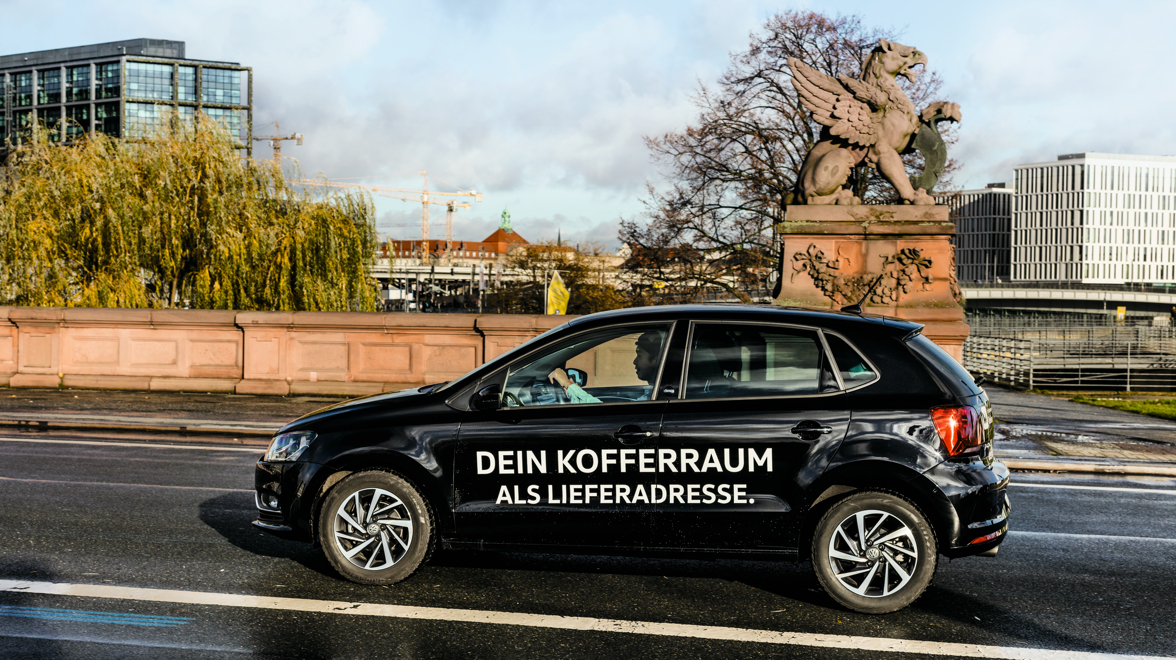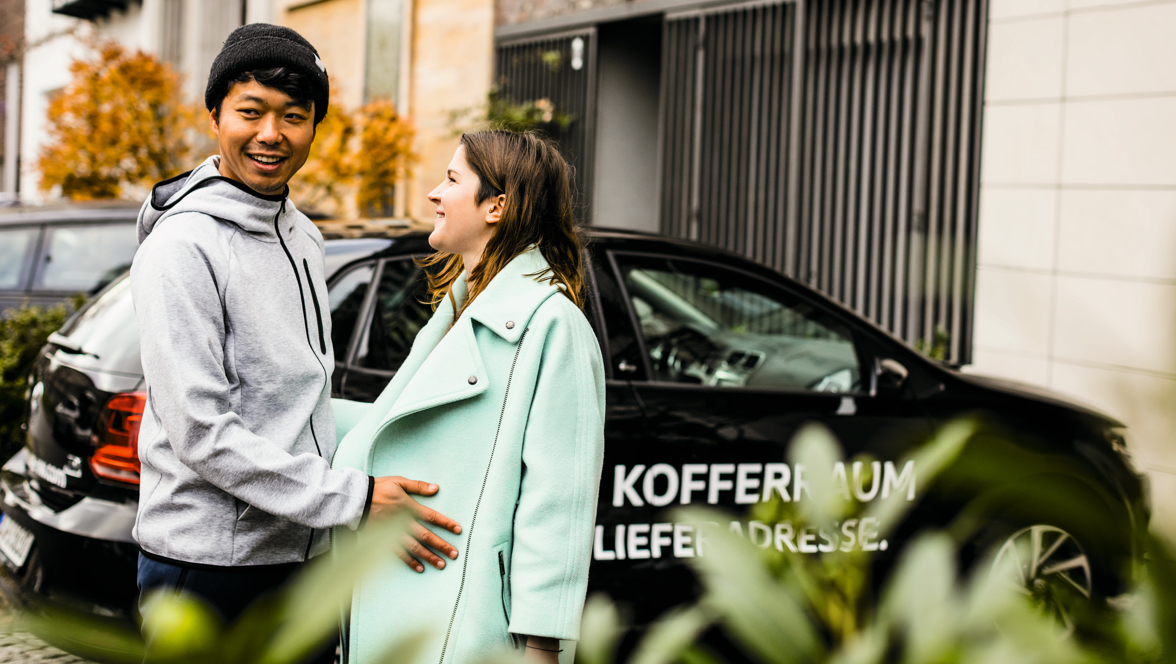The Volkswagen brand is building a big digital user platform. The We Deliver service is one element. We meet one of the testers.
It was worth it after all. Gufeng Zhou is pleased he braved the parking chaos in Berlin today. Just as well he left home a little earlier than usual this morning to find a good parking space for his Polo before starting work – his office is on the border between the Mitte and Friedrichshain districts, an area where parking spaces are in very short supply. The e-commerce firm that Gufeng works for has its headquarters there. And the email he has been expecting arrives at 11.45 a.m.: the parcel has been delivered.
“Yes! That will be the lamp.” Gufeng Zhou spotted the designer item from Sweden on Instagram at the end of last week and ordered it from an online retailer. Now, at last, it is waiting for him in the trunk of the Polo. The courier from the DHL Parcel service personally put it there, opening the trunk with the parcel scanner – and the help of a single-use access code that was issued by Volkswagen once Gufeng had notified the online retailer that the parcel should be delivered to the trunk of the car.
“A digital trend must make sense. I don’t go along with every marketing gag.”
Where is this service from Volkswagen available? In spring 2018, the answer is nowhere – yet. However, the planned service, called We Deliver, has already passed the intensive practical test with flying colors. Naturally, not everything is running smoothly yet. But the team at Volkswagen We, the brand’s digital mobility initiative, can work on the fine tuning using feedback from the 300 testers.
Volkswagen We
Volkswagen We is the name of the platform that includes individual services such as We Deliver or the We Park app. This means that Volkswagen always has its eye on the big picture when it comes to digital services.
All services are designed to meet specific customer needs, but at the same time they are also part of an interactive network. Today, mobile connectivity not only links the driver and car with the Internet, it also connects drivers and cars with one another. The Volkswagen We modules will deliver on that, too – at the latest by the time the Volkswagen ID is launched. The Volkswagen We universe will also encompass the service packages offered by Volkswagen Car-Net: Security & Service (automatic emergency call), Guide & Inform (traffic info), e-Remote (real-time info for e-models and hybrids) and App-Connect (smartphone integration).
Next steps for Volkswagen We: We Deliver will undergo trials in more cities in 2018. In the near future, We Park is to be rolled out across Europe and also made available for parking garages. In addition, the VW Connect vehicle data app, currently available in Spain for example, is also to be launched in other countries. The new cosmos is filling up nicely.

More than 800 people applied to test We Deliver. Gufeng Zhou, 33, is one of the successful candidates.
A cosmos of services and options
Gufeng Zhou, 33, is one of the people who have trialed We Deliver for four weeks – he was given a Polo to use for the test period. The service is one element in the Volkswagen We digital ecosystem, which will also include many other features. Going forward, Volkswagen AG will be organizing many of its mobility services in similar platforms. As digital ecosystems. As a cosmos of services, preference settings, sharing options, and much more.
To make a long story short, we will soon be logging into an account with the Volkswagen Group brands, just like we do now with Google or an Apple ID. The crucial factor will be designing these platforms to be as practical, intuitive, user-friendly, and connectable as possible. According to a forecast from the consulting firm McKinsey, global revenues from digital mobility services could reach US$1.5 trillion by 2030, one-quarter of all automotive revenues. The quality of the platforms will decide who comes out on top in attracting and keeping customers in this gigantic market.

Orders for delivery to the car trunk are placed with the online retailer. The participating cooperation partners list We Deliver as a delivery option.
Tomorrow’s ideal customer
The big players in Silicon Valley, too, are using this trend to set themselves apart from the rest. At the end of the day, it is not necessarily the biggest that wins, but the player that can provide the best customer experience. Jeff Bezos, CEO of Amazon, once said, “If you only take your lead from your competitors, then you are condemned to playing the waiting game. On the other hand, if you focus 100 percent on customers you can always be the pioneer.” What Volkswagen We is currently developing is already shaping up to be a visionary and eminently practical solution.
“I’m very willing to download apps if I think a digital trend is a good idea,” Gufeng Zhou says. “But I don’t go along with every marketing gag.” Gufeng, who was born in China, came to Germany in his early twenties, and has been living in Berlin since 2009. Today, he works as a data analytics manager in e-commerce.
He has always been an early adopter. He built his first computer as a 13-year-old student in China. Today, Gufeng makes use of all the mobile services he considers meaningful – from digital wallets to education apps. He doesn’t own a car, but uses car sharing up to three times a week. He has an account with sharing services for e-scooters and bikes, and is a real virtuoso when it comes to combining public transport, cars and two-wheelers. If you were to paint a picture of the ideal customer based on everything that has been written about urban mobility – Gufeng Zhou would be the perfect fit.
Meanwhile, it is afternoon in Berlin. Gufeng has quickly changed into his sports outfit at the office. Before he drives home, he wants to go for a jog along the bank of the River Spree. There are plenty of public parking options near Moltkebrücke. “That’s good for me in two ways, because it also means that the courier is able to deliver the parcel,” he says as he steers the Polo through the city.
“Flexibility is the most important thing for us. It’s how we can optimize our daily lives.”
The reason for that is because he is going to a birthday party at the weekend with his girlfriend Dijana. The birthday present is a special pair of sneakers. And Gufeng has arranged for them to be delivered to the trunk of the car – to the parking space near the Spree where the Polo can be found most afternoons. The trunk delivery service specifies a 300-meter radius for the car’s location to make sure the courier can deliver the parcel. “For me, this is the typical use case,” Gufeng says before he puts his headphones on. “I can go for a jog instead of queuing up at the post office.”
One piece in the We universe
There are plenty of situations in which this kind of delivery service can help solve problems. And it is important to remember that car trunk delivery is only one of many pieces in the jigsaw that makes up the Volkswagen We universe. We Park pays for your parking ticket by app, VW Connect sends easy-to-read vehicle data to your smartphone, the Car-Net services provide real-time information and navigation – the list goes on.
We Deliver is symptomatic of the vision for a Group-wide ecosystem for two reasons. First, it features one variety of what is known as the digital key. If the parcel courier can be authorized to open the trunk – then a friend or partner could also be sent the authorization to use the car without the added complication of handing over the key. People who do not own a car themselves could also be issued with a Volkswagen user ID. That opens up entirely new answers to the question: How does the industry define its customers?

“We’d even be willing to pay 50 cents more if the parcel was delivered straight to the car.” Dijana and Gufeng think the idea behind We Deliver is very convenient and practical.
Second, We Deliver demonstrates how cooperation can function. Six online retailers who use DHL as their carrier are participating in the field trials – that, too, is an important step toward the best user experience. However tough competition on digital markets may be, no online customer is willing to accept product boundaries that are too rigid. The brands must be aware of who they are and what they are, but they also need to stay compatible with the outside world.
We Deliver passed the demanding beta test on this particular afternoon. The message that the courier had found the car and delivered the sneakers came while Gufeng was still jogging. “No matter how many times it works, it’s still exciting,” Gufeng says when he shows Dijana the parcel once he has arrived back home. “Flexibility is the most important thing for us. It’s how we can optimize our daily lives. That’s what makes digitalization so valuable.”
Reliable and close to people – that was part of Volkswagen’s DNA in the analog age, and will likely be the best possible motto in the digital ecosystem of the future, too.
The big ecosystem
To take account of the transition in the automotive industry, all brands in the Volkswagen Group will sooner or later offer their customers platform solutions. Although the positioning will vary, all of these platforms will be based on the idea of an overarching system architecture. What features belong to an ecosystem?
User ID
The user ID is the log-in, the digital fingerprint, the unique code that gives a customer access to the ecosystem. And you do not need to buy a car from Volkswagen to be issued with a user ID. The goal for the future: an ID for every brand in the Group.
Digital key
Anyone with a user ID can use one – or several – digital key(s) via a smartphone. There are many situations where that not only comes in very handy, but also brings with it convenient additional functions. You want to lend your car to someone? You want the trunk to be opened to take delivery of something? Everything is possible – uncomplicated and mobile.
Vehicle settings
Personalization via user ID can turn a strange car into your own vehicle at the swipe of a smartphone. Infotainment system settings, seat position, heating and ambient lighting configurations – all just the way you like them in the other car thanks to the ecosystem.
Vehicle features
In the future it will also be possible to purchase and manage additional functions and special features for mobile use via the ecosystem accounts. That makes it easy to transfer certain assistance systems, infotainment content, and apps to other models in the Group portfolio.
Digital services
External ecosystem networking begins when external services become involved. The new Volkswagen We services are a good example. The We Park app is vehicle independent, We Deliver is an interface with cooperation partners. And the future has only just begun.

Gufeng Zhou can use the Polo equipped with We Deliver technology for four weeks. His girlfriend Dijana also thinks the service is useful.
